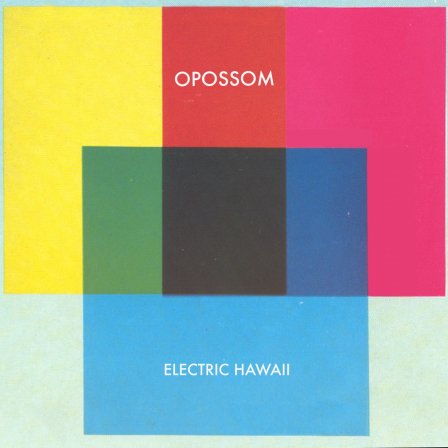Yes, you are reading that correctly. There’s a music act called Opossom, not to be confused with the Western Hemisphere’s largest order of marsupials, the opossum. Opossom is Kody Nielson, and after serving an eight-year tour as the front man for Kiwi art punk band the Mint Chicks, Kody holed himself up in his home studio while brother Ruban Nielson went off to form Unknown Mortal Orchestra. As visions of love and drugs danced in his head, Kody channeled his DIY work ethic into a solo album of shimmering neo-psychedelia.
As a genre, neo-psychedelia is certainly vague, but it’s also very prevalent. Generally, it refers to bands appearing in the late 70s onward, heavily influenced by the expansive, pioneering sounds of 60s psychedelia. Often, this is reflected by an obsession with jangly pop bands like The Beatles and The Byrds, but many find inspiration in early prog (Pink Floyd, King Crimson), surf/garage rock (The Sonics, 13th Floor Elevators), early electronic (BBC Radiophonic Workshop, library music), and experimental music (where the burgeoning bohemian lifestyle crossed over with academia and the avant-garde à la Terry Riley and The Velvet Underground).
Like most neo-psychedelic albums, Opossom’s debut is a mishmash of styles, homages, and effects held together by strands of ecstasy and personality. By and large, Electric Hawaii falls into the paisley pop vein, perhaps more toward the Monkees end of the spectrum than the Beatles end, but there are clear nods here and there to electronic and experimental music. At its core, under the ELO-/Club Merano-style vocoder vocals and simmering organ stabs, “Getaway Tonight” is drum ’n’ bass, while the title track, rather than being an obvious single, is a minute-and-a-half-long gurgling drone interlude. There are references to classic sounds, but nothing is presented in a plainly derivative fashion. There’s too much going on for such a simplistic reading.
I’m thinking part of the reason for the stylistic hodgepodge is the progress of time. For example, the closing “Inhaler Song” is, for the most part, an incredibly low-key, piano-led, lovelorn ballad about waiting by the phone, similar mood-wise to “All We Have Is Now” from The Flaming Lips’ Yoshimi Battles The Pink Robots, except that it devolves into a wall of organized distortion at the two-minute mark, a barrage of chunky noise that leans more toward the shoegazey noise pop of late-80s bands indebted to The Velvet Underground. “Song For Dan Treacy” from MGMT’s Congratulations, a spiritual cousin of Electric Hawaii, shows they were influenced by Television Personalities, who were themselves in the first wave of neo-psychedelic bands looking back at the 60s. These days, bands are being influenced by bands that were influenced by bands that were influenced by bands from the first wave of psychedelia, themselves formed in a lysergic haze from folk, blues, jazz, etc. Pop will eat itself, indeed.
Like taking videos of photographs of photocopies, each artistic processing of the original alters it in a way that purists immediately decry as being inferior. However, over time, these processes become admired for the intangible mystique and character each provides. Hence, the pervasive musicians’ desire for vintage gear that has long since been proven obsolete yet, through its fetishization, has also proven irreplaceable. It’s a reflection of the soul-bearing desire of idiosyncratic characters to present works of idiosyncratic character, often at great personal cost (RIP Skip Spence, Joe Meek, and Syd Barrett). Psychedelia was never about fitting in, but about going against the grain, expanding consciousness, and dreaming the dreams.
Like Kevin Barnes is to of Montreal, Anton Newcombe to The Brian Jonestown Massacre, Jeff Mangum to Neutral Milk Hotel, Robert Schneider to The Apples in Stereo, Wayne Coyne to The Flaming Lips, and Siouxsie to The Banshees, Kody Nielson is to Opossom. He is the band, an unquantifiable character that grounds a universe of equal parts mirth and growth, humor and honesty, a myriad of sounds and experiences from bygone eras filtered through lenses peering through lenses that we may never fully comprehend. Twee singer-songwriter and touring member Bic Runga’s sweet voice can be heard backing up and reinforcing the odd chorus, but aside from a little trumpet courtesy of Kody’s father Chris Nielson, that is the only help Kody received in this album’s creation. The rest is hard evidence of a distinct creative character taking flight.
Electric Hawaii has some undeniable highs. Similar to opening track “It’s Working” from Congratulations, “Girl” starts the album on a spirited note, melding a Pepe Deluxé-style pipe organ with a go-go early-60s pop shuffle and Beach Boys-like vocals. With a glittering chorus that elevates the track above the rest of the album, “Blue Meanies” was a great choice for a first single. It is every bit as upbeat, funky, and groovy as the unavoidable hit single “Young Folks” by Peter Bjorn and John. “Why Why” has a slick surf riff rocking on an upbeat shuffle that, when A-B’d, exposes all the shortcomings of “Beautiful Stranger,” Madonna’s uncommitted contribution to Austin Powers. “Cola Elixir” is a heavy dirge that could give most of the BJM catalog a run for its money, while “Outer Space” is a cutely romantic jam that wouldn’t be out of place on a Shawn Lee album (if only because Lee is another character, obsessed with vintage library and Moog records, and tends to record entire albums by himself).
Of course, Electric Hawaii isn’t perfect. For all the hints of yearning and even desperation that could be inferred from some of the lyrics, the overall feeling is shaped by a rather distancing pop cool, a certain unearned aloofness. But this album wasn’t intended to be generation-defining anyway. Electric Hawaii is just like the title sounds: a surf- and space-speckled blast of either guilt-free or guilty-pleasure music — whichever floats your boat.
More about: Opossom

